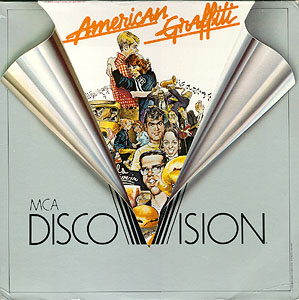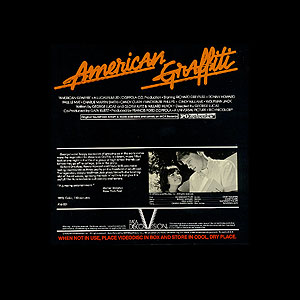
©1973 Universal Pictures. All rights reserved
| Catalog Number |
16-001 |
| Format |
Standard Play CAV |
| MPAA Rating |
 |
 |
| Stereo |
| Running Time |
110 minutes |


| Pressing Location |
DiscoVision Carson |
| Label Color |
Blue |
| Issued |
April 19, 1979 |
|
| Side |
Frames |
Running Time |
|
| 1 |
37,539 |
26min 04sec |
| 2 |
30,011 |
20min 51sec |
| 3 |
28,322 |
19min 40sec |
| 4 |
32,327 |
22min 27sec |
| 5 |
34,728 |
27min 48sec |
|
|
162,927 |
113min 09sec |
|
| Dead Side |
Various |
|
| Ratings |
|
| Video Transfer |
  |
| Audio Transfer |
 |
| Replication |
  |
|
| Packaging |
|
| Large Open-Top |
 |
| Open-Top |
 |
| Side-Open Sticker |
 |
| Printed |
 |
|
| Price History |
|---|
| Silver Catalog |
$15.95 |
| November 1979 |
$24.95 |
| May 1980 |
$24.95 |
| August 1980 |
$24.95 |
| October 1980 |
$24.95 |
|
Pressing Notes
When filmed in 1972, American Graffiti contained a mono soundtrack. However, sometime in 1975, George Lucas re-mixed the film to include stereo music and some rear channel sound effects. This is the version presented here on DiscoVision's first title in the "Comedy" catalog (the 16-xxx number sequence). The dialog is well controlled and steers nicely into the center channel on today's sophisticated Dolby Pro-Logic sound systems. However, it was never intended to be considered surround sound by any stretch. Throughout most of the film, the music takes on a heavy echo quality, which works great for creating the mood at the school dance on side 1 and the outdoor scenes at Mel's Diner. However, there are periods in the film where the audio is muted down, either in an attempt to subdue the soundtrack for other audio, or to try and create an atmosphere based on the scene. It works most of the time, but there are times when the process was simply done wrong. It's either a fault in the mix-down, or in the transfer.
The video transfer is very sharp. The colors are well behaved and since nearly the entire film takes place at night, the contrast is held in control. Some of the scenes are simply too dark however, loosing all detail. There is a problem on side 3 beginning at frame 8,675 and continuing until frame 13,580. This is the scene where Richard Dreyfuss is sitting on the car of a Phantom car club member and the other members confront him. Watch carefully and you'll see the red control simply fade on and off. When it's on, the image looks correct. When it fades out, everything is too blue. As soon as the scene is over, the problem disappears. It either the result of a bone-head colorist during the transfer from film or a faulty print. The Pan & Scan process really destroys most of the artistic composition of the film. George Lucas used the entire Panavision frame for this classic film and it really transfers badly in this edition. This transfer does reveal some interesting movie-making facts. There is a significant amount of "day for night" shooting on the film.
Initial shipments of American Graffiti had a "stereo" sticker on the shrink wrap in the lower right-hand corner. Later, this sticker was placed on the jacket itself. Other than the "after-printing" sticker, there is no mention of stereo anywhere on the jacket. The printed jacket version included the normal "stereo" artwork in the lower right corner on the front and either a red/white or yellow/black stereo band across bottom of the back.
The last appearance of the CAV version in a DiscoVision catalog was in October 1980.
Release History
American Graffiti was released by MCA Home Video on a 2 sided CLV disc in 1984 (Catalog #: 16001). A THX® certified widescreen (2.35:1) edition was issued in July 1996 and a Signature Collection edition was issued in October 1998. As was the style with George Lucas films, he tinkered with the film, specifically the sky background behind the opening shot of Mel's Diner in the opening sequence for this final LaserDisc release.
MCA DiscoVision Home Page
Updated: September 5, 2022
Copyright ©2005 Blam Entertainment Group







